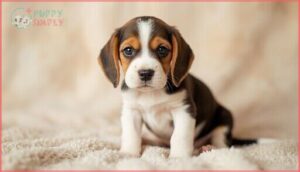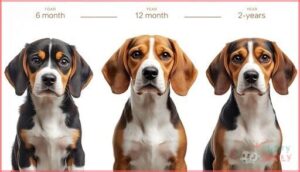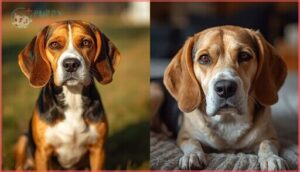This site is supported by our readers. We may earn a commission, at no cost to you, if you purchase through links.

Your tricolor Beagle puppy arrives home looking like a tiny tuxedo—mostly black with brown and white accents. Fast forward six months, and that same pup sports a rich tan saddle where the black used to dominate. This transformation catches many new owners off guard, but it’s completely normal.
Beagles don’t just change color once; their coats shift subtly throughout their lives, from puppyhood through their senior years. The pigments responsible for coat color respond to genetics, hormones, and even sunlight exposure.
Understanding these shifts helps you know what to expect as your Beagle matures, and more importantly, it helps you distinguish normal color changes from coat problems that need veterinary attention.
Table Of Contents
- Key Takeaways
- Do Beagles Change Color?
- Beagle Color Combinations and Patterns
- Beagle Puppy Color Development
- Genetic Factors in Beagle Color Change
- Aging and Long-Term Beagle Coat Changes
- Frequently Asked Questions (FAQs)
- How does nutrition impact a beagle’s coat color?
- What are some myths or misconceptions about color changes in beagles?
- Can diet affect my beagles coat color?
- Do seasonal changes impact beagle coat appearance?
- Are color changes linked to health problems?
- Can stress cause beagle coat color changes?
- Do indoor versus outdoor beagles change differently?
- Conclusion
Key Takeaways
- Beagles undergo dramatic coat color changes from puppyhood through adulthood, with most starting predominantly black and white before developing rich tan markings by six months and stabilizing around 12 months of age.
- These color shifts are controlled by genetics—specifically two pigments (eumelanin and phaeomelanin) regulated by genes like MC1R and ASIP—rather than indicating health problems in most cases.
- The AKC recognizes 25 different Beagle color combinations built from 10 base colors, with tricolor patterns (black saddle, tan points, white markings) being most common and unique features like ticking or freckles adding individual character.
- As Beagles age, natural greying typically begins around the muzzle between 5-7 years due to melanin reduction, and proper nutrition with amino acids like tyrosine and minerals like copper helps maintain coat vibrancy throughout their lives.
Do Beagles Change Color?
Yes, beagles do change color—sometimes dramatically. If you’ve noticed your beagle puppy looking different from the dog you brought home, you’re seeing a normal part of their development. Let’s look at what changes you can expect and why they happen.
Typical Color Changes From Puppy to Adult
As your Beagle puppy matures, you’ll notice dramatic color shift patterns that are completely normal. Most puppies start with distinct black and white markings, then develop tan point emergence around their face and legs by eight weeks.
Those fading black areas on the back gradually lighten to brown over the first year, transforming your pup’s appearance as adult color variations settle in. These changes reflect the fact that Beagles exhibit a range of AKC color combinations.
Why Beagle Coat Colors Shift Over Time
Understanding why those puppy colors transform into adult colors involves several biological factors working together. Color change in Beagles happens due to:
- Pigment Variation: Eumelanin and pheomelanin levels shift as your dog matures, affecting darkness and tone
- Color Genetics: Genes like MC1R and MITF regulate pigment production throughout life
- Hormonal Effects: Natural hormone changes during development alter melanin output
- Environmental Impact: Sunlight exposure can darken or bleach fur over time
- Nutritional Influence: Proper diet fosters healthy pigment production and vibrant coat appearance
Environmental factors can also influence Beagle’s coat color.
Beagle Color Combinations and Patterns
Beagles don’t come in just one look—they’re actually one of the most color-diverse breeds you’ll meet. The American Kennel Club recognizes 25 different color combinations, built from 10 base colors that mix and match in some pretty interesting ways.
Let’s walk through the patterns and markings you’re likely to see, from the classic tricolor to those distinctive ticking patterns.
Recognized AKC Color Combinations
The American Kennel Club recognizes 25 official Beagle color combinations built from 10 base colors: tan, white, brown, lemon, red, blue, black, bluetick, redtick, and fawn. While the classic black, tan, and white tricolor is most recognizable, you’ll find plenty of bicolor patterns like tan and white or lemon and white.
Rare variations include black, fawn, and white or bluetick combinations, showcasing the breed’s impressive genetic palette.
Common Tricolor and Bicolor Patterns
Of all those combinations, tricolor patterns dominate—you’ll see the classic black saddle with tan on the face, legs, and chest, plus white on the belly and paws.
Bicolor Beagles skip the saddle entirely, often showing lemon and white or tan and white combinations instead.
These coat pattern differences reflect tricolor genetics and bicolor markings that meet breed standards while showcasing natural color variance in Beagle coat colors.
Unique Markings: Ticking, Freckles, and Spots
Beyond the standard bicolor and tricolor patterns, you’ll notice unique coat texturing that adds individual character to your Beagle. Ticking patterns and spot markings develop during the first weeks of life as freckles emerge in white areas:
- Blue ticking creates gray-blue freckle development on black-based coats
- Red ticking produces orange-to-rust spotted markings on tan areas
- Density varies from light freckling to heavy roaning
These ticked Beagle markings reflect genetic color expression tied to white spotting patterns, with color variations more common in hunting lines.
Beagle Puppy Color Development
When you first bring home a Beagle puppy, you’ll notice their coat looks quite different from what it’ll eventually become. These color changes aren’t random—they follow a predictable pattern that most Beagles go through as they grow.
Let’s walk through what you can expect at each stage of your pup’s development.
Birth Colors and Early Appearance
When your Beagle puppy arrives home, you’ll likely notice a mostly black and white coat. This initial puppy coat is quite different from the adult version you’ll eventually see. White markings generally set by eight weeks, while black patches dominate early patterns. Many pups show distinct saddle patterns or ticking—those charming freckles on white areas that hint at future color development.
| Birth Appearance | What to Expect |
|---|---|
| Primary Colors | Black and white patches, limited tan |
| White Areas | Set by 8 weeks, include tail tip |
| Early Patterns | Saddle, ticking, and freckles visible |
Timeline of Color Maturation
During the first few weeks, you’ll see your puppy’s color shifts begin—darker patches emerge between one and four weeks old.
By three to six months, color intensification brings your pup closer to adult colors.
Most Beagles reach color stabilization timing around one year, though genetic influence timeline and environmental color impact can cause minor variations throughout the Beagle aging process.
When Adult Coat Colors Set
Your Beagle’s coat color stabilization happens around 12 months, marking the final color establishment you’ve been watching unfold. Most dramatic changes wrap up by one year, though the color maturation process can extend to two years as black areas lighten to brown.
- Puppy colors transform most dramatically in the first six months
- Adult coat timing varies slightly between individual dogs
- Mature coat characteristics generally stay consistent after one year
- Beagle color changes slow down markedly once maturity hits
Genetic Factors in Beagle Color Change
Your Beagle’s coat color isn’t random—it’s written in their DNA. Two main pigments, eumelanin and phaeomelanin, work together with specific genes to create those beautiful patterns you see.
Let’s look at how genetics actually control color changes from puppyhood through adulthood.
Key Pigments and Color Genes
Your Beagle’s coat color boils down to two pigments working together. Eumelanin produces black and brown tones, while phaeomelanin creates red and yellow shades.
Beagle coat colors come from two pigments: eumelanin creates blacks and browns, while phaeomelanin produces reds and yellows
Genes like MC1R and ASIP control pigment production in melanocytes, the cells responsible for color. Color dilution genes can lighten these pigments further.
Genetic testing now helps predict exactly which combinations your Beagle will develop as they mature.
How Genetics Influence Color Variation
Think of genetics as the blueprint determining which colors appear on your Beagle’s coat and when they emerge. Several key factors drive these color variations:
- Eumelanin production depends on MC1R gene variants, controlling black saddle intensity and placement
- Phaeomelanin control through ASIP genes creates tan point patterns and reddish tones
- Modifier genes like MITF influence white spotting distribution across your dog’s body
- Dilution effects and the domino allele add complexity, lightening pigments or creating unique patterns
Rare and Unusual Color Outcomes
While genetics usually produce familiar patterns, rare Beagle colors emerge when unusual gene combinations align. Solid black and blue Beagles, resulting from specific dilution genetics, appear in less than 2% of the breed.
Lemon-pied and badger-pied patterns create distinctive wild hare-like appearances. Red/black combinations and nonstandard color outcomes remain exceptionally uncommon. These rare variations showcase how complex genetics can override typical color change trajectories.
Aging and Long-Term Beagle Coat Changes
Your Beagle’s coat won’t stay the same forever. Just like people get salt-and-pepper hair, older Beagles develop their own version of grey as the years roll by.
Let’s look at what happens to your dog’s color as they age and how you can keep their coat looking healthy through every stage of life.
Greying and Color Fading With Age
Like all dogs, your Beagle’s coat will eventually show signs of age. Melanin reduction in hair follicles causes greying, usually starting around the muzzle between 5-7 years.
You’ll notice Beagle coat color changes including:
- Grey hairs appearing first on the face and ears
- Color fading in darker patches from sunlight exposure
- Coat texture becoming coarser over time
Premature greying before age 3 may signal health correlations worth discussing with your vet.
Maintaining Coat Health and Appearance
While you can’t stop natural Beagle coat color changes, you can keep your dog looking their best. Weekly brushing with rubber grooming mitts controls shedding and distributes oils for shine. Feed omega-rich foods to support coat nutrition and skin health. Bathe every 4-6 weeks with breed-appropriate shampoos.
Regular hair care preserves Beagle appearance and helps you spot changes in dog coat markings early.
Frequently Asked Questions (FAQs)
How does nutrition impact a beagle’s coat color?
You’re what you eat—and that rings true for beagle colors too. Amino acids like tyrosine, copper intake, and protein quality directly influence coat pigmentation, while vitamin support maintains vibrancy throughout puppy development and beyond.
What are some myths or misconceptions about color changes in beagles?
Many owners mistakenly believe fixed adult colors appear at birth or that black fur changes signal health issues.
External factors like sunlight can cause fading, while genetics naturally create non-uniform litter colors and puppy coat dilution.
Can diet affect my beagles coat color?
Your beagle’s diet plays a surprisingly powerful role in coat color vibrancy. Amino acids like tyrosine fuel pigment production, while minerals such as copper and zinc prevent fading, keeping those rich coat colors looking their best.
Do seasonal changes impact beagle coat appearance?
Yes, seasonal shedding cycles can subtly shift your beagle’s coat appearance. Spring and fall coat renewal may temporarily lighten black patches or alter color intensity due to environmental influences like UV exposure and changing fur density.
Are color changes linked to health problems?
Good news: normal color changes from puppy to adult aren’t red flags for health risks.
However, sudden coat deterioration, pigment disorders, or skin conditions like allergies may signal underlying beagle health problems requiring veterinary attention.
Can stress cause beagle coat color changes?
Stress generally doesn’t shift your Beagle’s base coat color, though anxiety premature graying may appear on the muzzle. Cortisol coat effects remain limited, while pigment production changes and trauma color shifts lack strong evidence in dogs.
Do indoor versus outdoor beagles change differently?
Like a photograph left in the sun, your Beagle’s coat may fade faster outdoors. Sunlight effects accelerate coat fading rates and color shift patterns in outdoor Beagles, while indoor dogs generally retain more stable pigmentation throughout Beagle puppy development.
Conclusion
Nothing about your Beagle’s appearance stays frozen in time—not the puppy-dark coat, not the bright tan that emerges, and not the silver whiskers that arrive later. When you ask “do beagles change color,” the answer is always yes.
Their coats evolve predictably from birth through old age. Track these shifts, celebrate each stage, and stay alert for unusual changes that signal health concerns. Your Beagle’s color story unfolds beautifully across their entire lifetime.












